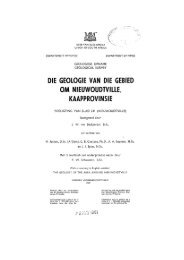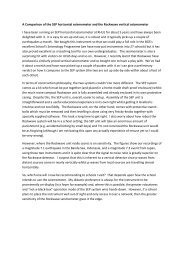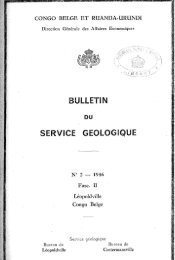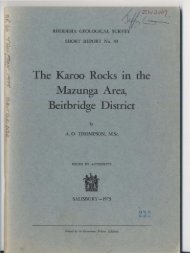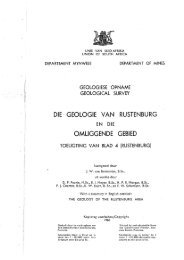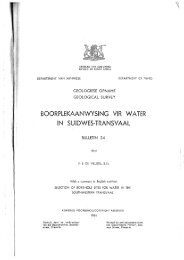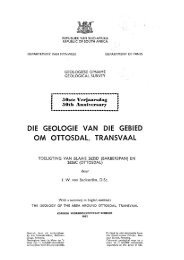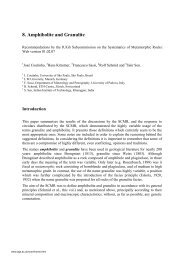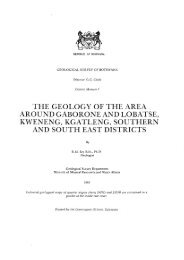Bibliography - British Geological Survey
Bibliography - British Geological Survey
Bibliography - British Geological Survey
Create successful ePaper yourself
Turn your PDF publications into a flip-book with our unique Google optimized e-Paper software.
Stringer, C. B. 2012. The 100-year mystery of Piltdown Man. Nature, 492 (13 Dec), 177‒179. (A team<br />
of 15 researchers from the Natural History Museum and several <strong>British</strong> universities are now examining the<br />
Piltdown finds using techniques such as radiocarbon dating and DNA and isotope studies in order to pin down<br />
the taxonomic identities and geographical origins of the specimens. Spectroscopy will be used to establish<br />
how many different staining methods were applied to the Piltdown assemblages of bones, teeth and tools.)<br />
Stringer, C. B., d’Errico, F., Williams, C. T., Housley, R. & Hedges, R. 1995. Solution for the Sherborne<br />
problem. Nature, 378, 452. (Letter describing the results of a detailed analysis of a supposed Palaeolithic<br />
engraving of a horse’s head on a mammalian rib, said to have been discovered in quarry debris at Sherborne,<br />
Dorset, and described by A. S. Woodward 1914. The engraving is shown to be a recent fake. See also report<br />
by Nigel Hawkes, ‘Prized Stone Age carving exposed as juvenile hoax’, The Times, 30 Nov 1995, p. 8. Other<br />
references to the Sherborne engraving will be found in the present <strong>Bibliography</strong>. See also Turrittin 2006, 12)<br />
Stringer, C. B. (see also under Spencer)<br />
Sussman, R. W. 2000. Piltdown Man: the father of American primatology. In: Primate encounters: models<br />
of science, gender, and society / edited by S. C. Strum & L. M. Fedigan. Chicago: University of Chicago<br />
Press, pp. 85–103.<br />
Sutcliffe, W. H. 1913. A criticism of some modern tendencies in prehistoric anthropology. Memoir and<br />
Proceedings of the Manchester Literary and Philosophical Society, 57, 1–25. (Piltdown, p. 3)<br />
Swinton, W. E. 1976. Physician contributions to nonmedical science: Sir Grafton Elliot Smith and Piltdown<br />
Man. Canadian Medical Association Journal, 115 (20 Nov), 1047‒1053.<br />
Symington, J. 1915. On the relations of the inner surface of the cranium to the cranial aspect of the brain.<br />
Edinburgh Medical Journal, 14, 85–100.<br />
Symington, J. 1916. Endocranial casts and brain form: a criticism of some recent speculations. Journal of<br />
Anatomy and Physiology, 50 (3), 111–130. (The author strongly disagrees with Elliott Smith’s interpretation<br />
of the Piltdown braincase and sees no peculiarity of development in the endocranial cast that would<br />
distinguish Eoanthropus from a modern human, pp 122–129.)<br />
Tappen, N. C. 1992 (contribution to discussion in Tobias 1992c)<br />
Tattersall, I. 1995. The fossil trail: how we know what we think we know about human evolution. New<br />
York: Oxford University Press. (Turritin cites pp. 48–51, 96–97)<br />
Taylor, R. M. S. 1937. The dentition of the Piltdown fossil man (Eoanthropus dawsoni) from a new aspect.<br />
Report Australian and New Zealand Association for the Advancement of Science, 23, 201, 245. (Title only ;<br />
for the text of this paper see Taylor 1978)<br />
Taylor, R. M. S. 1978. Variation in morphology of teeth: anthropologic and forensic aspects. Springfield,<br />
Illinois: Charles C. Thomas. (The text of a paper originally written in 1937, on the dentition of Piltdown<br />
Man, is here included as an appendix, pp. 362–370)<br />
Taylor, R. M. S. 1980. Piltdown echoes again. New Zealand Archaeology Association Newsletter, 23 (4),<br />
232–234.<br />
Teilhard de Chardin, P. 1913. La préhistoire et ses progrès. Etudes (Peres de la Compagnie de Jésus,<br />
Paris), nr. 134, 40‒53. For English translation see : Teilhard de Chardin, P. 1956. The appearance of man /<br />
translated by J. M. Cohen. New York: Harper & Row. (Francis Thackeray has argued that a sentence in this<br />
essay, which appeared in Jan 1913 a few weeks after the formal announcement of the discoveries at Piltdown,<br />
constitutes an admission of guilt by Teilhard. The opening sentence states that ‘There was a time when the<br />
study of prehistory deserved to be suspected or joked about’ (translated from the French). Thackeray’s<br />
translation (after J. M. Cohen) makes the final part of this statement read ‘... the subject of jokes’, which he<br />
takes to be an admission by Teilhard that English palaeontologists, including Smith Woodward, had been<br />
taken in by a joke (perpetrated by Teilhard). On the other hand, it may simply have been Teilhard’s way of<br />
saying that the subject of man’s prehistory had previously not been taken seriously, but had now finally come<br />
of age, thanks to the efforts of people like Hugo Obermaier and Marcellin Boule, both of whom taught at the<br />
Institut de Paléontologie Humaine in Paris, where Teilhard was then studying. Obermaier was about to<br />
publish his Der Mensch der Vorzeit, while Boule was due to complete the publication of a series of erudite



